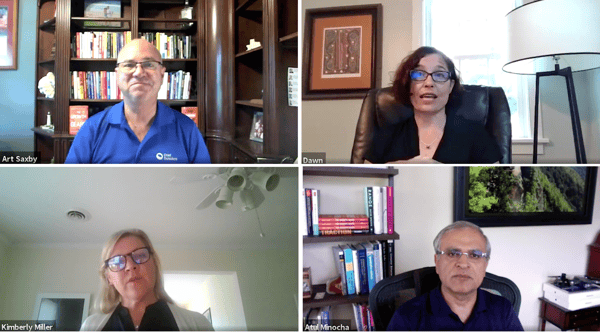CEO Blog - Advice for CEOs on growth and scaling
What can Industrial & Manufacturing CEOs do Right Now?

Industry Specific Advice for Marketing in a Time of Recovery from the Chief Outsider CMOs
The following summary encapsulates the highlights of a panel discussion for the Industrial Manufacturing sector hosted by Art Saxby and featuring CMOs Kimberly Miller, Atul Minocha and Dawn Werry. For the full benefit, view the discussion video in its entirety (15 minutes). Short of time? See the discussion highlights (6 minutes).
When the pandemic first hit, events for the industrial manufacturing sector were changing daily. Now, at the start of the recovery phase the entire industry is adapting. Some companies have had to find completely new markets for their products, while others have started making completely new products. Across the board, supply chains have been disrupted. Buyer behaviors have changed and go-to-market strategies have had to adjust in order to keep business moving.
Respond to Customer Needs
Even in the face of this disruption, some companies have refocused on what was not impacted and move in a new direction. Many proactively asked how their customers’ businesses were impacted, what new products or components might be needed and how they could respond quickly as soon as activity picked up again (or to adjust to a different set of parameters if business shifted).
In this environment it's very important for a company to understand the needs of their customer. It’s equally important for customers to believe that their suppliers care about them and are actually interested in understanding how situations might have changed and what can be done. Manufacturers have been forced to move from a position of, "we sell these products" to "what are the needs of my marketplace?"
New suppliers, new customers
Prior to the disruption caused by the pandemic, industrial companies in the US were heavily reliant on overseas suppliers. Many companies had ruled out buying from local or US vendors because they could get supplies from an overseas vendor at a better price. This is no longer a valid assumption as these supply chains have broken and the overseas reliance has shifted.
This creates an opportunity for US-based component manufacturers who previously were not able to compete. Buyers are now starting to consider domestic suppliers as a back-up, or even a preference to those overseas.
Evolving Go-to-Market Strategies
As changes unfold in the manufacturing space, go-to-market strategies have to adapt. Some companies have repurposed their salesforce, others are re-tooling their processes to adapt their products for new applications. This is opening up new markets, whether they are complementary, supplemental or brand-new.
Big changes to marketing strategy also necessitate changes to value propositions. If a company starts making new products, supplying different customers with US-built components or selling into a brand-new market, their messaging and value propositions need to be updated to reflect these changes.
Additionally, buyers in the industrial manufacturing sector have changed their behavior. They're not going to trade shows. They're not allowing a salesperson in the door. Without events and sales calls, companies have to consider alternative ways to engage suppliers and buyers.
Many industrial manufacturers have been slow to adopt modern marketing practices and may only have a basic web presence. This current situation has surfaced the importance of digital marketing. Websites are now crucial to clearly communicate a company’s message and value propositions. The website is a substitute for trade shows, product research, education, video demonstrations. Without the ability to meet face-to-face, customers that respond to outbound messaging, advertising, virtual events and educational videos are all funneled back to the website. It is a key tool for engaging and sharing with customers and prospects. As such, a digitally enabled website should be a priority going forward.
Agility. Not Prediction.
One piece of advice for a manufacturing CEO would be to steer conversations away from predictions like, "What will happen?” or “When it will happen?" and focus on preparing the organization to flex and switch fast. You could miss a window of opportunity if you invest money and waste time trying to predict what’s coming. We can’t know what's going to happen, or when. It's more about agility and less about the ability to predict.
If your organization is ever going to be receptive to new ideas, now is the time. This is the moment to pull your team together and say, "All right, let's look at this business differently. Let's build a plan. Let’s figure out what lever or set of levers to pull, when to pull them and how hard to pull. Let’s get ready.”
If you build that agility into your organization going forward, you have a better chance of flexing new strategies into action quickly. What you did in the past may not be adaptable to the new way of doing business, but positive steps you take today will equip you to meet tomorrow’s challenges.
Host:
Art Saxby, Founder & CEO, Chief Outsiders
Panelists:
Atul Minocha – Partner & CMO, Chief Outsiders:
- VP & CMO, Kodak Health Imaging
- VP & CMO, Smith & Nephew Orthopedics
- General Manager, Covance Cardiac Safety Services
- Director of Product Management, Honeywell Automotive
Kimberly Miller – CMO, Chief Outsiders:
- Global VP/GM Sales and Marketing, Rexnord
- VP Marketing, NTN Bearing Corporation
- VP Sales and Marketing, Rexnord
- VP Sales & Marketing, AAR
Dawn Werry – Partner & CMO, Chief Outsiders:
- Vice President of Global Marketing, Brink’s
- Vice President of Marketing, Milliken
- Global Marketing Leader, DuPont
Topics: CEO Choices, CEO Business Strategy, Manufacturing, Manufacturing & Distribution, COVID-19
Fri, Jul 10, 2020Featured Chief Outsider

Art Saxby
Related Articles

- Press Releases
- Careers
- Case Studies
- Marketing Consultant Company
- Marketing Strategy Consultants
- Marketing Plan Consultants
- B2B Marketing Consultants
- Virtual CMO
- Marketing Consultant Outsourcing
- Fractional CMO
- What is a Fractional CMO
- Healthcare Marketing Consultant
- Marketing Consultant Houston TX Texas
- Marketing Consultant Texas TX
- Marketing Consultant Bay Area
- CEO Blog
- Ebooks Plus
- Executive Marketing Consultants
- Product Marketing Consultants
- B2C Marketing Consultants
- Virtual Marketing Consultants
- Senior Marketing Consultants
- Temporary CMO
- Hire a CMO
- Fractional CMO Salary
- Fractional CMO Responsibilities
- Marketing Consultant Austin TX Texas
- Marketing Consultant Dallas TX Texas
- Marketing Consultant San Antonio
- Helping Private Equity
- Private Equity Blog
- Leadership Team
- Privacy Policy
- Business Marketing Consultants
- Strategic Marketing Consultants
- Marketing Technology Consultants
- Sales and Marketing Consultants
- CMO Job Description
- CMO Salary
- Fractional CMO Agency
- Fractional CMO Services
- CPG Marketing Consultant
- Marketing Consultant San Diego
- Partners
Houston, TX 77056
© 2023 Chief Outsiders


